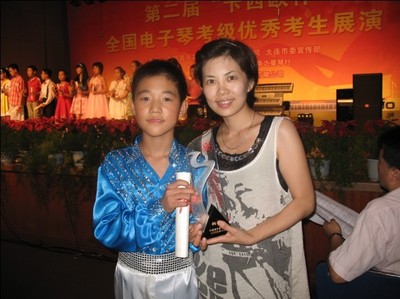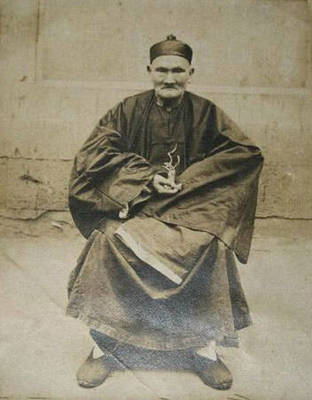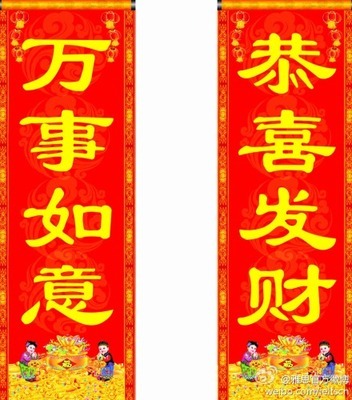英雄双行体Heroic Couplet
英雄双行体HeroicCouplet 也译为英雄联句,是英文双行体Couplet中的一种形式,英文双行体的定义如下:
Couplet: It is a pair of rhyming verse lines,usually of the same length; one of the most widely used verse-formsin European poetry. Chaucer established the use of couplets inEnglish, notably in the Canterbury Tales, using rhyming iambicpentameters later known as heroiccouplets
其特征与汉语的对联和骈文类似。如果学英文的人不知道英文中有双行体,那就如说汉语的人不知道汉语中有对联。正如汉语古诗要讲究平仄一样,英文的双行体亦讲究音步和音节。就像我们现在的好多人虽然了解汉语古诗词,但要自己创作那又是另外一回事了。就英文的学习来说,亦是如此,现在懂点外语的人多了,特别是懂点英文的人更多,故好多人就以为自己懂英文了。实际上,好多人连最基本的英文儿歌都没有读过,那就更谈不上经典的英文诗了。我曾经对人说,中国有十几亿人讲汉语,为什么都不能去大学的中文系或文学院当教授,在全球化的今天,一个人也不能因为自己会说英语就当大学英文系的教授,当然我们国家的情况比较特殊,有些人做了多年的英文教授,连一首英文诗歌也不知道,其水平就不用我在此多说了,还有人从国外回来后说,自己的英文比自己的母语——汉语都好。我在课堂给本科和研究生都说过,这种人的话一概不能听,因为这只能证明其汉语poor(差),英文worse(更差)。我知道我说这话会得罪人的,但我还是要说,诸位如若不信,可以问一问自己身边的一些人,正如现在的国学届很少有大师一样,现在的英文届也是如此。我国英文教授中的南郭先生很多,用我的话来说,大多只会看图识字,这话已是抬举人的话了。这些年来,我坚持为研究生开设英文诗歌课,遭到好多人的不屑。我教诗、写诗(偶尔写汉语诗)和翻译诗,虽然谈不上有所成就,能不误人子弟就感到很欣慰了。看到网上有人提到了英诗中的英雄双行体,颇觉高兴,就简单的介绍一下这一诗体。
Heroic Couplet:英雄双行体A rhyming couplet of iambic pentameter, often “closed”,i.e., containing a complete thought, there being a fairly heavypause at the end of the first line and a still heavier one at theend of the second. Commonly there is a parallel or antithesiswithin a line, or between the two lines. It is heroic because inEngland, especially in the eighteenth century, it was much used forheroic (epic) poems.
英雄双行体属于双行诗,由两个押韵的抑扬格五音步诗行构成,常包含一个完整的意思。第二句结尾力度加强,句中常用平行对偶结构。在英国,特别是在十八世纪,这种诗体常被用来写英雄史诗,因而得名。
The Heroic Couplet at a Glance
1.It is a rhyming pair oflines.
2.The meter is usually iambicpentameter but may also be tetrameter.
3.A pentameter couplet had tensyllables with alternating stresses.

4.The rhyme scheme progresses asaabbcc, etc.
5.the heroic couplet, so-called,denoted that it was a form in which a high subject matter could bewritten. This was the form often used for translation of epicpoetry from the classical Latin and Greek.
6.It works by adapting the oldChaucerian line and allowing a strong pause or caesura in themiddle of the line.
7.The caesura usually comes afterthe fifth or sixth syllable. Its sharp rhymes and regular beat madeit widely used in the sixteenth, seventeenth, and eighteenthcenturies for epigrammatic and satirical poetry.
The History of the Form.
At first glance, the couplet seems to be an element of form ratherthan a form in itself. It evolved out of parts of a poem, and onemodel of a line in particular—Chaucer’s spacious rhyming couplet.This is one of the few forms that we have not annotated with acontemporary context. We mean this section to be almost a smalllaboratory to show how a single , unassuming form could suddenlyrise to express the grander hopes of atime.
Even as a useful, witty, and musical unit, no one could havepredicted the extraordinary development in the couplet thathappened in the sixteenth century. Suddenly poets began to think,to argue, and to explain in the couplet. This then took the name“the heroic couplet,” denoting a high subjectmatter.
By the eighteenth century the heroic couplet reigned supreme. Thesharp, end-stop rhymes, the regular stresses, and the pause thathappened in the middle of the line all made it perfect formoralizing, warning, satirizing, and poking fun at another’sexpense.
In many cases, for the poets who adopted it so enthusiastically inthe eighteenth century, the heroic couplet became a self-consciousreconnection to a golden age of wit and closure. Samuel Johnson’sThe Vanity of HumanWishes for example is subtitled The Tenth Satire of Juvenal Imitatedby Samuel Johnson.
In the Augustan Age when order was the dream, and decorum anecessity, the couplet seemed a micro-model of the age’sintentions: closed-in, certain, attractive to the reason, andfinally, reassuring to the limits of that elegantworld.
Thecouplet allows us to observe an element of form becoming a form: bythe eighteenth century the heroic couplet—for good and ill—was aform. It began to shape the concept of the poem, as well assensibility became an emblem for thetimes.
最后举一首英文儿歌中的双行体字母歌
TomThumb’s Alphabet
A was an arche, and shot at afrog;
B was a butcher, and kept abull-dog.
C was captain, all covered withlace;
D was a drunkard, and had a redface.
E was an esquire, with insolentbrow;
F was a farmer, and followed theplough.
G was a gamester, who had but illluck;
H was a hunter, and hunted abuck.
I was an innkeeper, who loved tocarouse;
J was a joiner, and built up ahouse.
K was a king, so mighty andgrand;
L was a lady, who had a whitehand.
M was a miser, and hoarded upgold;
N was a nobleman, gallant andbold.
O was an oyster girl, and went abouttown;
P was a parson, and wore a blackgown.
Q was a queen, who sailed in aship;
R was a robber, and wanted awhip.
S was a sailor, and spent all hegot;
T was a tinker, and mended apot.
U was a usurer, a miserableelf;
V was a vintners, who drank allhimself.
W was a watchman, and guarded thedoor;
X was expensive, and so becamepoor.
Y was a youth, that did not loveschool;
Z was a zany, a poor harmlessfool.
-------From Children’s literature, P35
Rand MeNally & Companyby
Charles Madison Curry andErle
Elsworth Clippinger.
 爱华网
爱华网



